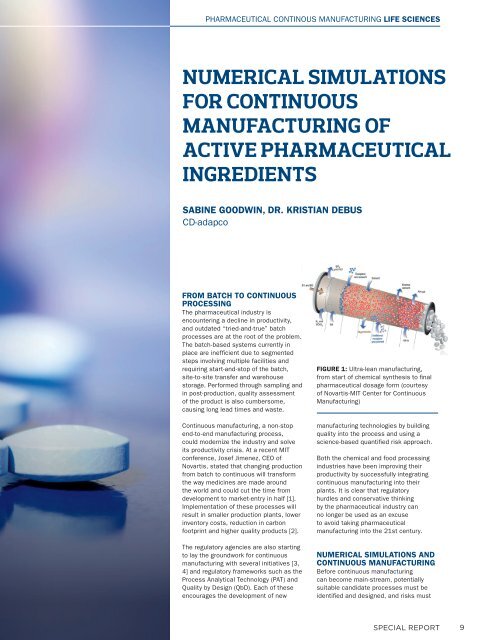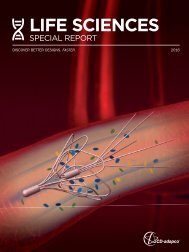Life Science Special Report December 2015
The Life Sciences Sector is experiencing an unprecedented change...
The Life Sciences Sector is experiencing an unprecedented change...
- No tags were found...
You also want an ePaper? Increase the reach of your titles
YUMPU automatically turns print PDFs into web optimized ePapers that Google loves.
PHARMACEUTICAL CONTINOUS MANUFACTURING LIFE SCIENCES<br />
NUMERICAL SIMULATIONS<br />
FOR CONTINUOUS<br />
MANUFACTURING OF<br />
ACTIVE PHARMACEUTICAL<br />
INGREDIENTS<br />
SABINE GOODWIN, DR. KRISTIAN DEBUS<br />
CD-adapco<br />
FROM BATCH TO CONTINUOUS<br />
PROCESSING<br />
The pharmaceutical industry is<br />
encountering a decline in productivity,<br />
and outdated “tried-and-true” batch<br />
processes are at the root of the problem.<br />
The batch-based systems currently in<br />
place are ineffi cient due to segmented<br />
steps involving multiple facilities and<br />
requiring start-and-stop of the batch,<br />
site-to-site transfer and warehouse<br />
storage. Performed through sampling and<br />
in post-production, quality assessment<br />
of the product is also cumbersome,<br />
causing long lead times and waste.<br />
Continuous manufacturing, a non-stop<br />
end-to-end manufacturing process,<br />
could modernize the industry and solve<br />
its productivity crisis. At a recent MIT<br />
conference, Josef Jimenez, CEO of<br />
Novartis, stated that changing production<br />
from batch to continuous will transform<br />
the way medicines are made around<br />
the world and could cut the time from<br />
development to market-entry in half [1].<br />
Implementation of these processes will<br />
result in smaller production plants, lower<br />
inventory costs, reduction in carbon<br />
footprint and higher quality products [2].<br />
The regulatory agencies are also starting<br />
to lay the groundwork for continuous<br />
manufacturing with several initiatives [3,<br />
4] and regulatory frameworks such as the<br />
Process Analytical Technology (PAT) and<br />
Quality by Design (QbD). Each of these<br />
encourages the development of new<br />
FIGURE 1: Ultra-lean manufacturing,<br />
from start of chemical synthesis to fi nal<br />
pharmaceutical dosage form (courtesy<br />
of Novartis-MIT Center for Continuous<br />
Manufacturing)<br />
manufacturing technologies by building<br />
quality into the process and using a<br />
science-based quantifi ed risk approach.<br />
Both the chemical and food processing<br />
industries have been improving their<br />
productivity by successfully integrating<br />
continuous manufacturing into their<br />
plants. It is clear that regulatory<br />
hurdles and conservative thinking<br />
by the pharmaceutical industry can<br />
no longer be used as an excuse<br />
to avoid taking pharmaceutical<br />
manufacturing into the 21st century.<br />
NUMERICAL SIMULATIONS AND<br />
CONTINUOUS MANUFACTURING<br />
Before continuous manufacturing<br />
can become main-stream, potentially<br />
suitable candidate processes must be<br />
identifi ed and designed, and risks must<br />
SPECIAL REPORT<br />
9



